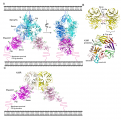Our bodies heavily rely on calcium ions (Ca2+). Their concentration in the cell cytoplasm is normally low under resting conditions, and its influx through specialized ion channels drives many functions ranging from muscle contraction, regulating heart beats, secretion of hormones and neurotransmitter, transcription of specific genes, and more. Ca2+ can enter the cytoplasm either from the extracellular space, or from intracellular stores. One such store is the ER (endoplasmic reticulum) and its membrane contains Ca2+ selective ion channels that open under controlled conditions. The main channel that regulates the Ca2+ release from the ER is the Ryanodine Receptor (RyR), a huge protein up to 2.2 MDa in size that generates the bulk Ca2+ signal required for the contraction of both skeletal and cardiac muscle.
Approximately 1,700 scientists visit SSRL annually to conduct experiments in broad disciplines including life sciences, materials, environmental science, and accelerator physics. Science highlights featured here and in our monthly newsletter, Headlines, increase the visibility of user science as well as the important contribution of SSRL in facilitating basic and applied scientific research. Many of these scientific highlights have been included in reports to funding agencies and have been picked up by other media. Users are strongly encouraged to contact us when exciting results are about to be published. We can work with users and the SLAC Office of Communication to develop the story and to communicate user research findings to a much broader audience. Visit SSRL Publications for a list of the hundreds of SSRL-related scientific papers published annually. Contact us to add your most recent publications to this collection.
A desire to create machines that can explore their environments, like people do, through the sensations of feeling and touch, has inspired researchers to develop artificial skin. An ideal electronic skin would be flexible and sensitive to even minor touches, such as the weight of an insect. Such a touch-sensitive material could be used for human prosthetics, sensory input devices for robotics, and applications where the biologic and electronic communicate.
MATE transporters are responsible for the exportation of various substrates and toxins from cells of bacteria, plants, and mammals using a proton or sodium gradient. Plants use them to transport metabolites, and they are important for tolerance to aluminum in soil, an important factor for crop yield. In bacteria and mammals, MATE transporters are important for multiple-drug resistance, which affects the efficacy of many medicines. Although these transporters play such important roles, much about how they work is not understood.
Semaphorins are a group of proteins known for their critical role in nerve and vascular development and are bound by signaling receptors called Plexins. Some Semaphorins, including Sema7A, are involved in a variety of immune responses. Vaccinia virus, which is used in the smallpox vaccine, has a Sema7A homologue called A39R, which binds PlexinC1, Sema7A's receptor.
X-ray microscopy is a useful tool for visualizing functional materials on the nanoscale. X-ray holography replaces the lens with a computer and obtains an image by Fourier inversion of the interference pattern. While in principle the resolution limit is given by the x-ray wavelength, in practice, the resolution is limited by the size of the reference being used.
Discovering high performing organic semiconductors is a hot area of research, as we look for efficient, low-cost materials that can be used in inexpensive electronic devices, such as flexible solar cells and radio frequency ID tags. To design effective materials, the relationship between a material’s structure and its semiconductive properties must be found. Research on p-type (hole conducting) organic semiconductors has shown π-bond stacking to be important in determining the semiconducting properties. The newer, n-type (electron conducting) class of organic semiconductors has not been as extensively studied.
Three dimensional topological insulators are new state of quantum matter with a bulk gap and odd number of relativistic Dirac fermions on the surface. In the presence of the time reversal symmetry, these Dirac fermions are massless with a continuous Dirac point (Fig. 1a), immune to perturbations as long as the disorder potential does not violate the time reversal symmetry.
The smallest organisms should not be overlooked when finding solutions to the problem of increasing pollutants and greenhouse gases in our atmosphere. Each year, some microorganisms using the enzyme carbon monoxide dehydrogenase (CODH) take an estimated 100 million tons of carbon monoxide (CO) from our air, while others use CODH to produce 10 billion tons of acetate from carbon dioxide (CO2).
Anthropologists learn about ancient cultures through the objects left behind. Ritualistic artifacts give glimpses into the religious and belief systems of nonextant societies. Application of new techniques of chemical and structural analysis to the study of ancient objects can give more insight into how they were made and used.
The capsid that surrounds viruses is formed from subunit proteins that interact in specific ways to form a tight shell. The processes of coming together and forming interactions are multistep and complex and are fundamental events to acquire viral infectivity. The capsid maturation process of the Nudaurelia capensis omega virus includes pH-dependant conformational changes and auto-proteolysis. Like many human viruses such as HIV and herpes virus, NwV, an insect virus, requires these specific structural changes to become infectious.













